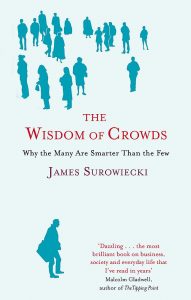
In cases where there is a deficiency of information, a “good” crowd would still be able to make fair, unbiased and rational decisions. Whereas a “bad” crowd may lack crucial aspects, such as diversity or independence, and may produce incorrect judgements.
Herd mentality can undermine the potential of crowd decisions.
Groups may often reach incorrect decisions, despite being large and diverse.
The 5 elements required to form a wise crowd are:
1. Diversity of opinions
2. Independence
3. Decentralization
4. Aggregation
5. Trust
Having a diverse group of decision-makers, James Surowiecki writes “helps because it actually adds a perspective that would otherwise be absent and because it takes away, or at least weakens, some of the destructive characteristics of group decision making”.
# Key Takeaways:
– Diversity of opinions and perspectives within a group can lead to better decision-making and problem-solving.
– The collective intelligence of a group can often surpass that of an individual expert.
– The accuracy of a group’s decision-making can be improved by ensuring independence, diversity, and decentralization within the group.
– The “wisdom of crowds” phenomenon can be applied to a wide range of scenarios, from predicting outcomes to creating innovative solutions.
# Practical Applications:
– In business, leaders can use the wisdom of crowds to gather diverse perspectives and ideas from their team when making important decisions.
– In marketing, companies can utilize crowdsourcing to gather feedback and ideas from a large group of consumers.
– In politics, polling and prediction markets can be used to gauge public opinion and make more accurate predictions.
– In education, teachers can encourage collaboration and group work to tap into the collective intelligence of their students.
# Valuable Insights for Leaders and Managers:
– Chapter 3: “The Difference Between Markets and Hierarchies” discusses the advantages and disadvantages of decentralized decision-making and how it can be applied in organizations.
– Chapter 4: “The Diversity Prediction Theorem” explains how diversity within a group can lead to more accurate predictions and decision-making.
– Chapter 5: “The Efficient Market Hypothesis” explores the concept of collective intelligence and how it can be harnessed for better decision-making.
# Case Studies and Examples:
– The prediction market for the 2008 U.S. presidential election, where the collective intelligence of the market accurately predicted the outcome.
– The success of open-source software development, where a diverse group of individuals collaboratively create innovative solutions.
– The failure of the Bay of Pigs invasion, where a lack of diversity and independence within the decision-making group led to a flawed plan.
Leave a Reply